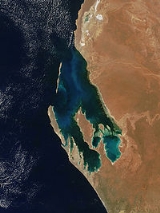
Shark Bay, Western Australia
Encyclopedia
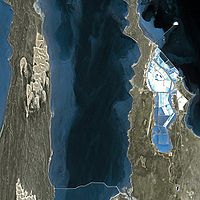
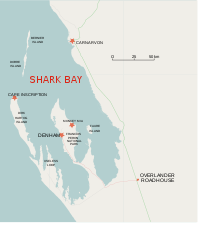
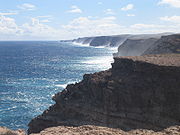
World Heritage Site
A UNESCO World Heritage Site is a place that is listed by the UNESCO as of special cultural or physical significance...
in the Gascoyne region of Western Australia
Western Australia
Western Australia is a state of Australia, occupying the entire western third of the Australian continent. It is bounded by the Indian Ocean to the north and west, the Great Australian Bight and Indian Ocean to the south, the Northern Territory to the north-east and South Australia to the south-east...
. It is an area centred approximately on 25°30′S 113°30′E, 800 kilometres north of Perth
Perth, Western Australia
Perth is the capital and largest city of the Australian state of Western Australia and the fourth most populous city in Australia. The Perth metropolitan area has an estimated population of almost 1,700,000....
, on the westernmost point of Australia
Australia
Australia , officially the Commonwealth of Australia, is a country in the Southern Hemisphere comprising the mainland of the Australian continent, the island of Tasmania, and numerous smaller islands in the Indian and Pacific Oceans. It is the world's sixth-largest country by total area...
. An expedition led by Dirk Hartog
Dirk Hartog
Dirk Hartog was a 17th century Dutch sailor and explorer. Dirk Hartog's expedition was the third European group to land on Australian soil. He was the first to leave behind an artifact to record his visit, the Hartog plate. His name is sometimes alternatively spelled Dirck Hartog or Dierick...
happened upon the area in 1616, becoming the second group of Europe
Europe
Europe is, by convention, one of the world's seven continents. Comprising the westernmost peninsula of Eurasia, Europe is generally 'divided' from Asia to its east by the watershed divides of the Ural and Caucasus Mountains, the Ural River, the Caspian and Black Seas, and the waterways connecting...
ans known to have visited Australia. Shark Bay was named by William Dampier
William Dampier
William Dampier was an English buccaneer, sea captain, author and scientific observer...
, in 1699.
The area has a population of fewer than 1,000 people and a coastline of over 1,500 kilometres. The half-dozen small communities making up this population occupy less than 1% of the total area.
Shark Bay World Heritage site
The World Heritage status of the region was created and negotiated in the 1990s.Landforms
The bay itself covers an area of 10,000 km², with an average depth of 10 metres. It is divided by shallow banks and has many peninsulas and islands. The coastline is over 1,500 km long. There are about 300 km of limestoneLimestone
Limestone is a sedimentary rock composed largely of the minerals calcite and aragonite, which are different crystal forms of calcium carbonate . Many limestones are composed from skeletal fragments of marine organisms such as coral or foraminifera....
cliffs overlooking the bay. One spectacular segment of cliffs in known as the Zuytdorp Cliffs
Zuytdorp Cliffs
The Zuytdorp Cliffs extend for about 150 km along a rugged, spectacular and little visited segment of the Western Australian Indian Ocean coast in Shark Bay. The cliffs extend from just north of the mouth of the Murchison River at Kalbarri, to Pepper Point south of Steep Point...
. The bay is located in the transition zone between three major climatic regions and between two major botanical
Botany
Botany, plant science, or plant biology is a branch of biology that involves the scientific study of plant life. Traditionally, botany also included the study of fungi, algae and viruses...
provinces.
Dirk Hartog Island
Dirk Hartog Island
Dirk Hartog Island is an island off the Gascoyne coast of Western Australia, within the Shark Bay World Heritage Area. It is about 80 kilometres long and between 3 and 15 kilometres wide and is Western Australia's largest and most western island. It covers an area of 620 square kilometres and is...
is of historical significance due to landings upon it by early explorers. In 1616, Dirk Hartog landed at Inscription Point on the north end of the island and marked his discovery with a pewter plate
Hartog Plate
Hartog Plate or Dirk Hartog's Plate is either of two plates, although primarily the first, which were left on Dirk Hartog Island during a period of European exploration of the western coast of Australia prior to European settlement there...
, inscribed with the date and nailed to a post. This plate was then replaced by Willem de Vlamingh and returned to Holland. It is now kept in the National Museum of Holland. There is a replica in the Shark Bay Discovery Centre in Denham.
Bernier
Bernier Island
Bernier Island is one of three islands that comprise the Bernier and Dorre Island Nature Reserve in the Shark Bay World Heritage area in Western Australia.It was a hospital location in the early 1900s....
and Dorre
Dorre Island
Dorre Island is one of three islands that make up the Bernier and Dorre Island Nature Reserve in the Shark Bay World Heritage area in Western Australia...
islands in the north-west corner of the heritage area are among last-remaining habitats of Australian mammals threatened with extinction. They are used, with numerous other smaller islands throughout the marine park, to release threatened species that are being bred at Project Eden in François Peron National Park. These islands are free of feral non-native animals which might predate the threatened species, and so provide a safe haven of pristine environment on which to restore species that are threatened on the mainland.
The Australian Wildlife Conservatory is the guardian of Faure Island
Faure Island
Faure Island is a 58 km2 island pastoral lease and nature reserve, east of the Francois Peron National Park on the Peron Peninsula, in Shark Bay, Western Australia. It lies in line with the Monkey Mia resort to the west, and the Wooramel River on the eastern shore of Shark Bay...
, off Monkey Mia
Monkey Mia
Monkey Mia is a popular tourist resort located about 800 km north of Perth, Western Australia. The resort is 25 km northeast of the town of Denham in the Shark Bay Marine Park and World Heritage Site....
. Seasonally, turtle
Turtle
Turtles are reptiles of the order Testudines , characterised by a special bony or cartilaginous shell developed from their ribs that acts as a shield...
s come here to nest and are the subject of studies conducted in conjunction with the Western Australian Department of Environment and Conservation (DEC) on this sheltered island.
Fauna
Shark Bay is an area of major zoologicalZoology
Zoology |zoölogy]]), is the branch of biology that relates to the animal kingdom, including the structure, embryology, evolution, classification, habits, and distribution of all animals, both living and extinct...
importance. It is home to about 10,000 dugong
Dugong
The dugong is a large marine mammal which, together with the manatees, is one of four living species of the order Sirenia. It is the only living representative of the once-diverse family Dugongidae; its closest modern relative, Steller's sea cow , was hunted to extinction in the 18th century...
s (sea cows), around 12.5% of the world's population, and there are many Indo-Pacific bottlenose dolphins, particularly at Monkey Mia. The dolphins here have been particularly friendly since the 1960s. The area supports 26 threatened
Threatened species
Threatened species are any speciesg animals, plants, fungi, etc.) which are vulnerable to endangerment in the near future.The World Conservation Union is the foremost authority on threatened species, and treats threatened species not as a single category, but as a group of three categories,...
Australian mammal
Mammal
Mammals are members of a class of air-breathing vertebrate animals characterised by the possession of endothermy, hair, three middle ear bones, and mammary glands functional in mothers with young...
species, over 230 species of bird
Bird
Birds are feathered, winged, bipedal, endothermic , egg-laying, vertebrate animals. Around 10,000 living species and 188 families makes them the most speciose class of tetrapod vertebrates. They inhabit ecosystems across the globe, from the Arctic to the Antarctic. Extant birds range in size from...
, and nearly 150 species of reptile
Reptile
Reptiles are members of a class of air-breathing, ectothermic vertebrates which are characterized by laying shelled eggs , and having skin covered in scales and/or scutes. They are tetrapods, either having four limbs or being descended from four-limbed ancestors...
. It is an important breeding and nursery ground for fish
Fish
Fish are a paraphyletic group of organisms that consist of all gill-bearing aquatic vertebrate animals that lack limbs with digits. Included in this definition are the living hagfish, lampreys, and cartilaginous and bony fish, as well as various extinct related groups...
, crustacean
Crustacean
Crustaceans form a very large group of arthropods, usually treated as a subphylum, which includes such familiar animals as crabs, lobsters, crayfish, shrimp, krill and barnacles. The 50,000 described species range in size from Stygotantulus stocki at , to the Japanese spider crab with a leg span...
s, and coelenterate
Cnidaria
Cnidaria is a phylum containing over 9,000 species of animals found exclusively in aquatic and mostly marine environments. Their distinguishing feature is cnidocytes, specialized cells that they use mainly for capturing prey. Their bodies consist of mesoglea, a non-living jelly-like substance,...
s. There are over 323 fish species, with many shark
Shark
Sharks are a type of fish with a full cartilaginous skeleton and a highly streamlined body. The earliest known sharks date from more than 420 million years ago....
s and rays
Batoidea
Batoidea is a superorder of cartilaginous fish commonly known as rays and skates, containing more than 500 described species in thirteen families...
.
Some Bottlenose Dolphin
Bottlenose Dolphin
Bottlenose dolphins, the genus Tursiops, are the most common and well-known members of the family Delphinidae, the family of oceanic dolphins. Recent molecular studies show the genus contains two species, the common bottlenose dolphin and the Indo-Pacific bottlenose dolphin , instead of one...
s in Shark Bay exhibit one of the few known cases of tool use in marine mammals (along with sea otters
Sea Otter
The sea otter is a marine mammal native to the coasts of the northern and eastern North Pacific Ocean. Adult sea otters typically weigh between 14 and 45 kg , making them the heaviest members of the weasel family, but among the smallest marine mammals...
): they protect their nose with a sponge
Sea sponge
Sponges are animals of the phylum Porifera . Their bodies consist of jelly-like mesohyl sandwiched between two thin layers of cells. While all animals have unspecialized cells that can transform into specialized cells, sponges are unique in having some specialized cells, but can also have...
while foraging for food in the sandy sea bottom. Humpback
Humpback Whale
The humpback whale is a species of baleen whale. One of the larger rorqual species, adults range in length from and weigh approximately . The humpback has a distinctive body shape, with unusually long pectoral fins and a knobbly head. It is an acrobatic animal, often breaching and slapping the...
and Southern right whale
Southern Right Whale
The southern right whale is a baleen whale, one of three species classified as right whales belonging to the genus Eubalaena. Like other right whales, the southern right whale is readily distinguished from others by the callosities on its head, a broad back without a dorsal fin, and a long arching...
s use the waters of the bay as migratory staging post. The endangered green and loggerhead turtles nest on the bay's sandy beaches. The largest fish in the world, the whale shark
Whale shark
The whale shark, Rhincodon typus, is a slow-moving filter feeding shark, the largest extant fish species. The largest confirmed individual had a length of and a weight of more than , but unconfirmed claims report considerably larger whale sharks...
, gathers in the bay during the April and May full moons.
Flora
Shark Bay has the largest known area of seagrassSeagrass
Seagrasses are flowering plants from one of four plant families , all in the order Alismatales , which grow in marine, fully saline environments.-Ecology:...
, with seagrass meadows covering over 4,800 km² of the bay. It includes the 1,030 km² Wooramel Seagrass Bank
Wooramel Seagrass Bank
Wooramel Seagrass Bank is a large deposit of carbonate sediment, a sand bank, formed by diverse communities of seagrasses off the coast of Carnarvon, Western Australia. The mattes of seagrass meadows and stands consolidate a shallow platform of sandy substrate by acting as an organic baffle against...
, the largest seagrass bank in the world. Shark Bay also contains the largest number of seagrass species ever recorded in one place; twelve species have been found, with up to nine occurring together in some places. The seagrasses are a vital part of the complex environment of the bay. Over thousands of years, sediment and shell fragments have accumulated in the seagrasses to form vast expanses of seagrass beds. This has raised the sea floor, making the bay shallower. Seagrasses are the basis of the food chain in Shark Bay, providing home and shelter to various marine species and attracting the dugong population.
In Shark Bay's hot, dry climate, evaporation greatly exceeds the annual precipitation rate. Thus, the seawater in the shallow bays becomes very salt-concentrated, or 'hypersaline'. Seagrasses also restrict the tidal flow of waters through the bay area, preventing the ocean tides from diluting the sea water. The water of the bay is 1.5 to 2 times more salty than the surrounding ocean waters.
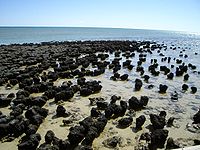
Stromatolites
3,000 years ago microbes started building up stromatolites in Hamelin Pool in the south of the bay. These structures are the earliest signs of life on Earth, with some fossilized ones being found from 3,500 million years ago (though the biological origin of these fossils is disputed) at North Pole, also in Western Australia, and are considered the longest continuing biological lineage. They were first identified in 1956 here in Hamelin Pool as a living species, before that only being known in the fossil record, so they are living fossils. Hamelin Pool contains the most diverse and abundant examples of living stromatolite forms in the world. It is now hypothesized that some of these stromatolites contain a new form of chlorophyllChlorophyll
Chlorophyll is a green pigment found in almost all plants, algae, and cyanobacteria. Its name is derived from the Greek words χλωρος, chloros and φύλλον, phyllon . Chlorophyll is an extremely important biomolecule, critical in photosynthesis, which allows plants to obtain energy from light...
, chlorophyll f
Chlorophyll f
Chlorophyll f is a hypothesized form of chlorophyll that absorbs further in the red than other chlorophylls. It was reported from stromatolites from Western Australia's Shark Bay....
.
Protected area
Shark Bay was inscribed as a World Heritage Site in 1991. The site covers an area of 23,000 square kilometres. It includes many protected areas and conservation reserves, including Shark Bay Marine ParkShark Bay Marine Park
Shark Bay Marine Park is located at Shark Bay World Heritage Site, Western Australia, over north of Perth. It is the site of the world's largest seagrass meadows, with a total of twelve species of seagrass in the park....
, Francois Peron National Park
Francois Peron National Park
Francois Peron National Park is a national park on the Peron Peninsula in Western Australia , 726 km north of Perth, and located within the boundary of the Shark Bay World Heritage area...
, Hamelin Pool Marine Nature Reserve
Hamelin Pool Marine Nature Reserve
Hamelin Pool Marine Nature Reserve is located in the Shark Bay World Heritage Site of Western Australia adjacent to the historic Hamelin Pool Telegraph Station about west of the Overlander Roadhouse on the North West Coastal Highway. Access is via Hamelin Pool Rd and then through the Hamelin Pool...
, Zuytdorp Nature Reserve and numerous protected islands.
Denham
Denham, Western Australia
Denham is the administrative town for the Shire of Shark Bay, Western Australia. At the 2006 census, Denham had a population of 607.Located on the western coast of the Peron Peninsula north of Perth, Denham is the westernmost town in Australia, and is named in honour of Captain Henry Mangles...
and Useless Loop both fall within the boundary of the site but are specifically excluded from it. Shark Bay was the first to be classified on the Australian World Heritage list.
Discovery Centre
Facilities around the World Heritage area, provided by the Shire of Shark Bay and DEC, include a new Discovery Centre in Denham which provides interactive displays and comprehensive information about the features of the region.Access
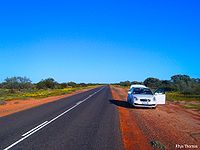
Shark Bay Airport
Shark Bay Airport is an airport located on the Peron Peninsula within the Shark Bay World Heritage site in the Gascoyne region serving Monkey Mia, a resort in Western Australia, and the nearby town of Denham....
, and by the World Heritage Drive, a 150 km link road between Denham
Denham, Western Australia
Denham is the administrative town for the Shire of Shark Bay, Western Australia. At the 2006 census, Denham had a population of 607.Located on the western coast of the Peron Peninsula north of Perth, Denham is the westernmost town in Australia, and is named in honour of Captain Henry Mangles...
and the Overlander Roadhouse on the North West Coastal Highway
North West Coastal Highway
North West Coastal Highway in Western Australia is a generally north-south Western Australian highway which links the fishing town of Geraldton with the iron ore port of Port Hedland. It is long, and constructed as a sealed 2-lane single carriageway with overtaking lanes in some parts. It was...
.
National Parks and Reserves
- Bernier IslandBernier IslandBernier Island is one of three islands that comprise the Bernier and Dorre Island Nature Reserve in the Shark Bay World Heritage area in Western Australia.It was a hospital location in the early 1900s....
- Dorre IslandDorre IslandDorre Island is one of three islands that make up the Bernier and Dorre Island Nature Reserve in the Shark Bay World Heritage area in Western Australia...
- Charlie Island
- Francois Peron National ParkFrancois Peron National ParkFrancois Peron National Park is a national park on the Peron Peninsula in Western Australia , 726 km north of Perth, and located within the boundary of the Shark Bay World Heritage area...
- Friday Island
- Hamelin Pool Marine Nature ReserveHamelin Pool Marine Nature ReserveHamelin Pool Marine Nature Reserve is located in the Shark Bay World Heritage Site of Western Australia adjacent to the historic Hamelin Pool Telegraph Station about west of the Overlander Roadhouse on the North West Coastal Highway. Access is via Hamelin Pool Rd and then through the Hamelin Pool...
- Hamelin Pool/East Faure Island High-Low Water Mark
- Koks Island
- Monkey MiaMonkey MiaMonkey Mia is a popular tourist resort located about 800 km north of Perth, Western Australia. The resort is 25 km northeast of the town of Denham in the Shark Bay Marine Park and World Heritage Site....
- Shark Bay Marine ParkShark Bay Marine ParkShark Bay Marine Park is located at Shark Bay World Heritage Site, Western Australia, over north of Perth. It is the site of the world's largest seagrass meadows, with a total of twelve species of seagrass in the park....
- Shell Beach Conservation Park
- Small Islands
- Zuytdorp Nature ReserveZuytdorp CliffsThe Zuytdorp Cliffs extend for about 150 km along a rugged, spectacular and little visited segment of the Western Australian Indian Ocean coast in Shark Bay. The cliffs extend from just north of the mouth of the Murchison River at Kalbarri, to Pepper Point south of Steep Point...
Bays of World Heritage area
- Hamelin Pool
- Henri Freycinet HarbourHenri Freycinet HarbourHenri Freycinet Harbour also known as Freycinet Estuary is one of the inner gulfs of Shark Bay World Heritage area that lies to the west of the Peron Peninsula....
- L'Haridon BightL'Haridon BightL'Haridon Bight is one of the bays on the eastern side of the Peron Peninsula in the Shark Bay World Heritage Site in the Gascoyne region of Western Australia....
Peninsulas of the World Heritage area
- Bellefin Prong
- Heirisson Prong
- Carrarang Peninsula
- Peron PeninsulaPeron PeninsulaPeron Peninsula is a long narrow peninsula located in the Shark Bay World Heritage site in Western Australia, at about 25o51' S longitude and 113o30' E latitude. It is some 80 miles long, running north-northwesterly, located east of Henri Freycinet Harbour and west of Havre Hamelin and Faure...
IBRA sub regions of the Shark Bay Area
The Shark Bay area has three bioregions within the IBRAIbra
Ibra is the second largest city in the Ash Sharqiyah Region of Oman. It is located about 140 km from Muscat and has a population estimated at 35,000 people....
system: Carnarvon, Geraldton Sandplains, and Yalgoo.
They are further divided into subregions
- CarnarvonCarnarvon (biogeographic region)Carnarvon is an Interim Biogeographic Regionalisation for Australia region in Western Australia. This area is also referred to physiographically as the Carnarvon Basin, where it is a physiographic province of the larger West Australian Shield division....
bioregion (CAR) –- Wooramel sub region (CAR2) – most of Peron Peninsula and coastline east of Hamelin Pool
- Cape Range sub region (CAR1) – (not represented in area)
- Geraldton SandplainsGeraldton SandplainsGeraldton Sandplains is an Interim Biogeographic Regionalisation for Australia region in Western Australia and part of the larger Southwest Australia savanna ecoregion.It has two sub regions: -* Geraldton Hills sub region* Lesuer sub region...
bioregion (GS) –- Geraldton Hills sub region (GS1) – Zuytdorp Nature Reserve area
- Leseur sub region (GS2) – (not represented in area)
- YalgooYalgoo (biogeographic region)Yalgoo is an Interim Biogeographic Regionalisation for Australia region in Western Australia and part of the larger Southwest Australia savanna ecoregion.In the IBRA system it has the code of , and it has two sub-regions:...
bioregion (YAL) –- Tallering sub region (YAL2) (not represented in area)
- Edel subregion (YAL1) – Bernier, Dorre and Dirk Hartog Islands
See also
- Search for HMAS Sydney and HSK Kormoran
- List of islands in Shark Bay
Further reading
- Edward DuykerEdward DuykerEdward Duyker is an Australian historian and author born in Melbourne, Victoria, to a father from the Netherlands and a mother from Mauritius...
François Péron: An Impetuous Life: Naturalist and Voyager, Miegunyah/MUP, Melb., 2006, p. 349, ISBN 978 0522 85260 8 [winner Frank Broeze Maritime History Prize, 2007]
External links
Official websites:Additional information:
- World heritage listing for Shark Bay, Western Australia
- UNESCOUNESCOThe United Nations Educational, Scientific and Cultural Organization is a specialized agency of the United Nations...
World Heritage Centre: Shark Bay, Western Australia

